Discover 50 houseplants 🌱💙that will paint your living space with captivating shades of blue. From soothing succulents to fragrant blooms and vibrant vines, these blue beauties are not only visually stunning but also low-maintenance, making them perfect companions for both novice and experienced indoor gardeners.
Learn how to care for each unique plant and transform your home into a blue-hued paradise.

50. Blue-Green Schefflera (Schefflera arboricola)

Why it’s a great houseplant: The Blue-Green Schefflera boasts glossy, variegated leaves with hints of blue and green, making it an attractive and air-purifying addition to indoor spaces. To enhance its blue-green appearance, provide bright, indirect light and regular pruning to maintain its shape.
Care Tips:
- Light: Place in bright, indirect light; it can tolerate some direct sunlight.
- Water: Keep the soil consistently moist but not waterlogged, and allow the top inch of soil to dry between waterings.
- Pruning: Trim regularly to encourage bushy growth and maintain its vibrant foliage.
49. Blue-Purple Vriesea (Vriesea spp.)
Why it’s a great houseplant: Blue-Purple Vriesea is a stunning bromeliad known for its striking blue and purple hues, adding a touch of tropical elegance to indoor spaces while improving air quality. To maintain its colorful appearance, provide bright, indirect light and follow proper bromeliad care.
Care Tips:
- Light: Place in bright, indirect light, away from direct sunlight.
- Water: Keep the central cup filled with water and change it regularly. Water the soil sparingly to prevent overwatering.
- Temperature: Maintain a warm, humid environment for optimal growth.
48. Blue Flowering Maple (Abutilon spp.)
Why it’s a great houseplant: Blue Flowering Maple is a charming indoor plant with pendulous, bell-shaped blue flowers, ideal for adding color and elegance to your indoor garden. To encourage its lovely blue blossoms, provide bright, indirect light and proper care.
Care Tips:
- Light: Place in bright, indirect light or filtered sunlight.
- Water: Keep the soil evenly moist but not soggy. Ensure good drainage to prevent root rot.
- Pruning: Trim occasionally to maintain its shape and encourage more blooms.
47. Blue Cholla Cactus (Cylindropuntia spp.)
Why it’s a great houseplant: Blue Cholla Cactus is a unique succulent with blue-gray cylindrical stems that add a desert-inspired aesthetic to your indoor environment. It’s a low-maintenance plant that thrives with minimal care, making it an ideal choice for beginners.
Care Tips:
- Light: Provide plenty of bright, indirect sunlight.
- Water: Water sparingly, allowing the soil to dry completely between waterings.
- Soil: Use well-draining cactus or succulent potting mix.
46. Blue Starburst Bromeliad (Neoregalia spectabilis)
Why it’s a great houseplant: Blue Starburst Bromeliad is a captivating bromeliad species known for its blue-green rosette and vibrant central bloom. It’s an excellent choice for adding a tropical touch to your indoor space and purifying the air.
Care Tips:
- Light: Place in bright, indirect light to maintain its vibrant colors.
- Water: Keep the central cup filled with water, and mist the plant regularly.
- Temperature: Maintain a warm, humid environment for optimal growth.
45. Blue Euphorbia (Euphorbia lactea ‘Blue’)
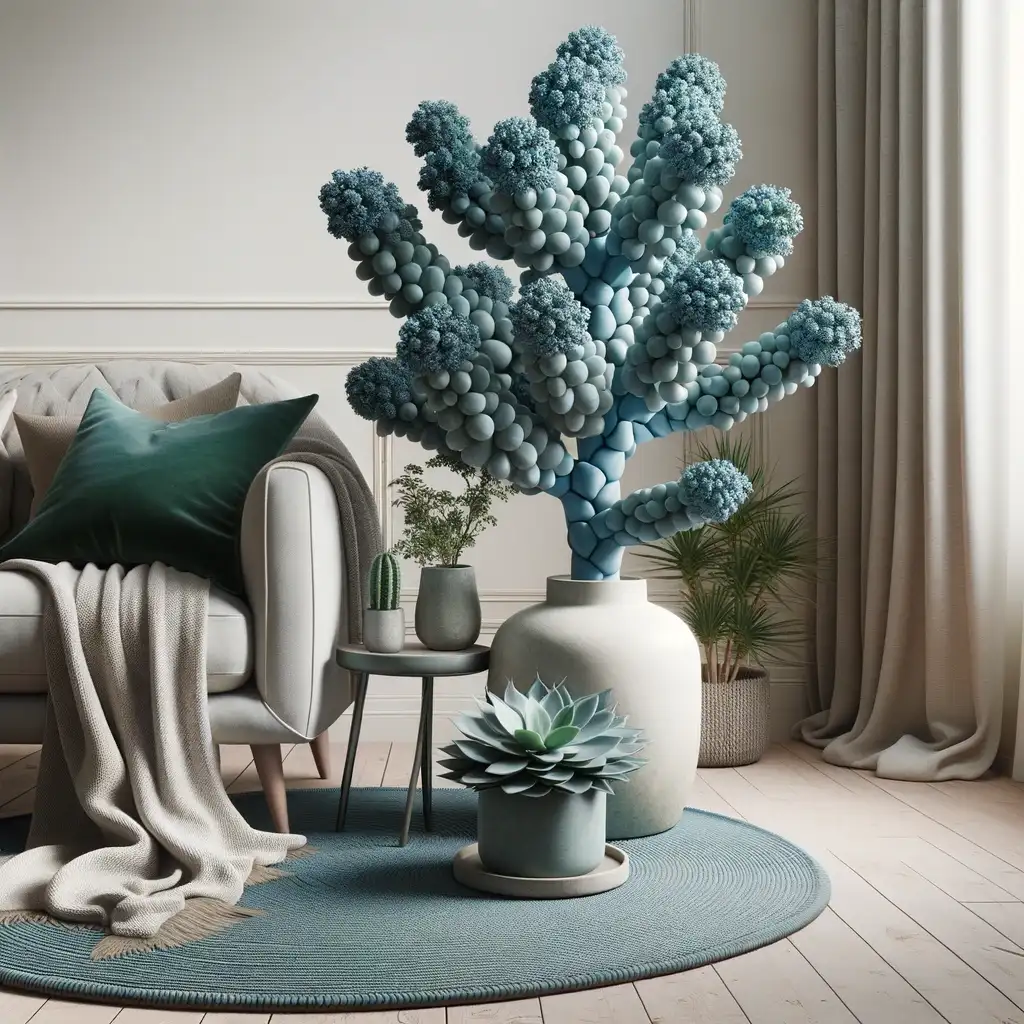
Why it’s a great houseplant: Blue Euphorbia is a striking succulent with a unique bluish hue and intriguing branching patterns. It’s drought-tolerant and requires minimal maintenance, making it an ideal choice for busy indoor gardeners.
Care Tips:
- Light: Provide bright, indirect light or filtered sunlight.
- Water: Water sparingly, allowing the soil to dry completely between waterings.
- Soil: Use a well-draining cactus or succulent potting mix.
44. Blue Nolina (Beaucarnea recurvata)
Why it’s a great houseplant: Blue Nolina, also known as the Ponytail Palm, features a distinctive bulbous trunk and blue-green, strap-like leaves. It’s an eye-catching and low-maintenance plant that adds a touch of the exotic to indoor spaces.
Care Tips:
- Light: Place in bright, indirect light.
- Water: Allow the soil to dry out between waterings, as it’s drought-tolerant.
- Temperature: Keep it in a room with moderate temperatures.
43. Blue Kalanchoe (Kalanchoe thyrsiflora)
Why it’s a great houseplant: Blue Kalanchoe, also known as “Paddle Plant,” showcases beautiful blue-gray, paddle-shaped leaves. It’s not only visually appealing but also a hardy succulent that thrives indoors with minimal care.
Care Tips:
- Light: Provide bright, indirect sunlight.
- Water: Water sparingly, allowing the soil to dry out between waterings.
- Soil: Use well-draining cactus or succulent potting mix.
42. Blue Orchid Cactus (Epiphyllum oxypetalum)

Why it’s a great houseplant: The Blue Orchid Cactus, or “Queen of the Night,” produces stunning bluish-white flowers that bloom at night. It’s a unique and captivating addition to any indoor garden, known for its fragrant, nocturnal blooms.
Care Tips:
- Light: Place in bright, indirect light with some morning sun.
- Water: Keep the soil evenly moist during the growing season, but reduce watering in the winter.
- Temperature: Maintain a warm environment, as it’s sensitive to cold temperatures.
41. Blue Chalk Sticks (Senecio serpens)
Why it’s a great houseplant: Blue Chalk Sticks is a low-growing succulent with powdery blue, cylindrical leaves. It’s an excellent choice for adding a pop of color and a touch of the Southwest to your indoor garden, and it’s drought-tolerant.
Care Tips:
- Light: Provide bright, indirect light.
- Water: Water sparingly, allowing the soil to dry thoroughly between waterings.
- Soil: Use well-draining cactus or succulent potting mix.
40. Blue Hoya (Hoya kerrii)

Why it’s a great houseplant: Blue Hoya, also known as “Heart Leaf Hoya,” has striking blue-green, heart-shaped leaves. It’s a delightful and low-maintenance vining plant that adds a touch of charm to any indoor space.
Care Tips:
- Light: Place in bright, indirect light.
- Water: Allow the soil to dry slightly between waterings, and be cautious not to overwater.
- Humidity: Maintain moderate humidity levels for optimal growth.
39. Blue Peperomia (Peperomia rotundifolia)
Why it’s a great houseplant: Blue Peperomia, with its trailing stems and small, round leaves with a bluish-green tint, is a charming addition to hanging baskets or tabletop arrangements. It’s an easy-care plant that’s perfect for small indoor spaces.
Care Tips:
- Light: Provide bright, indirect light.
- Water: Keep the soil slightly moist but avoid overwatering.
- Humidity: It thrives in higher humidity levels.
38. Blue Sweet Pea Shrub (Polygala myrtifolia)
Why it’s a great houseplant: The Blue Sweet Pea Shrub is known for its clusters of blue to purple flowers and dense foliage. It’s a visually appealing and fragrant houseplant that adds a delightful touch to indoor gardens.
Care Tips:
- Light: Place in bright, indirect light.
- Water: Keep the soil consistently moist but not waterlogged.
- Pruning: Trim to maintain its shape and encourage more blooms.
37. Blue Dracaena (Dracaena marginata ‘Colorama’)
Why it’s a great houseplant: Blue Dracaena, a variety of the popular Dracaena Marginata, features striking bluish-green leaves edged with red. It’s an excellent choice for adding height and a pop of color to your indoor space, and it’s known for its air-purifying qualities.
Care Tips:
- Light: Provide bright, indirect light.
- Water: Allow the soil to dry out slightly between waterings.
- Pruning: Trim to control its size and maintain its colorful foliage.
36. Blue Salvia (Salvia farinacea)
Blue Salvia, scientifically known as Salvia farinacea, is a popular perennial herbaceous plant that belongs to the mint family, Lamiaceae. It is native to Texas and Mexico but is widely cultivated in gardens and landscapes for its striking blue flowers and its ability to attract pollinators, such as bees and butterflies. Blue Salvia is renowned for its vibrant and long-lasting blooms, making it a favorite among garden enthusiasts.
Care Tips:
- Light: Blue Salvia thrives in full sun to partial shade conditions, requiring at least 6-8 hours of direct sunlight per day for optimal growth.
- Water: Water the plant when the soil has dried slightly between waterings to prevent overwatering, and ensure it receives adequate moisture during dry spells.
- Humidity: Blue Salvia is adaptable to a wide range of humidity levels, making it suitable for both arid and moderately humid climates.
35. Blue Corkscrew Rush (Juncus effusus ‘Blue Arrow’)
Why it’s a great houseplant: Blue Corkscrew Rush is an eye-catching indoor plant with unique, twisting blue-green stems that resemble corkscrews. It adds a touch of whimsy and texture to your indoor garden while thriving in wet or boggy conditions.
Care Tips:
- Light: Provide bright, indirect light or partial shade.
- Water: Keep the soil consistently moist but not waterlogged.
- Humidity: Maintain higher humidity levels, especially in drier indoor environments.
34. Blue Mist Shrub (Caryopteris x clandonensis)
Why it’s a great houseplant: The Blue Mist Shrub features fragrant, blue-purple flowers and silvery-blue foliage, making it an attractive and aromatic addition to indoor gardens. It also attracts pollinators like bees and butterflies.
Care Tips:
- Light: Place in bright, indirect light or partial sun.
- Water: Keep the soil consistently moist, especially during the growing season.
- Pruning: Prune in late winter or early spring to promote bushier growth and more blooms.
33. Blue Potato Bush (Lycianthes rantonnetii)
Why it’s a great houseplant: The Blue Potato Bush, with its vibrant blue to purple flowers and dense foliage, adds a burst of color and visual interest to indoor spaces. It’s a versatile plant that can thrive both indoors and outdoors in containers.
Care Tips:
- Light: Provide bright, indirect light or partial sun.
- Water: Keep the soil evenly moist but avoid waterlogging.
- Fertilization: Feed with a balanced liquid fertilizer during the growing season.
32. Blue Himalayan Poppy (Meconopsis betonicifolia)
Why it’s a great houseplant: Blue Himalayan Poppy is renowned for its stunning true-blue flowers, making it a rare and captivating choice for indoor cultivation. Its striking blooms add a touch of elegance and beauty to your indoor garden.
Care Tips:
- Light: Provide bright, indirect light or partial shade.
- Water: Keep the soil consistently moist but not waterlogged.
- Cool Temperatures: Maintain cooler temperatures to mimic its natural habitat.
31. Blue Glorybower (Clerodendrum ugandense)
Why it’s a great houseplant: Blue Glorybower features clusters of bright blue tubular flowers and lush green foliage, attracting hummingbirds and butterflies. It’s a beautiful and vibrant addition to indoor spaces, adding a pop of color and attracting pollinators.
Care Tips:
- Light: Place in bright, indirect light or partial sun.
- Water: Keep the soil evenly moist during the growing season.
- Pruning: Prune to maintain its shape and encourage blooming.
30. Blue Forget-Me-Not (Myosotis spp.)
Why it’s a great houseplant: Blue Forget-Me-Not is known for its tiny, delicate, blue flowers and its symbolism of remembrance. It’s a sentimental and charming indoor plant, perfect for adding a touch of nostalgia to your home decor.
Care Tips:
- Light: Provide bright, indirect light or partial shade.
- Water: Keep the soil consistently moist, but avoid waterlogging.
- Cool Temperatures: Maintain cooler indoor temperatures for optimal growth.
29. Blue Paradise Bush (Dichorisandra thyrsiflora)
Why it’s a great houseplant: Blue Paradise Bush, with its stunning blue-purple flowers and bold, tropical foliage, adds a touch of exotic beauty to indoor spaces. It’s a unique and visually appealing choice that thrives in well-lit indoor environments.
Care Tips:
- Light: Provide bright, indirect light to encourage blooming.
- Water: Keep the soil consistently moist but not waterlogged.
- Humidity: Maintain higher humidity levels for optimal growth.
28. Blue Ginger (Dichorisandra thyrsiflora)
Why it’s a great houseplant: Blue Ginger is an attractive indoor plant known for its rich blue flowers and lush green foliage. It adds a tropical and vibrant element to indoor gardens while being relatively easy to care for.
Care Tips:
- Light: Place in bright, indirect light.
- Water: Keep the soil consistently moist, especially during the growing season.
- Humidity: Provide moderate to high humidity for best results.
27. Blue Daze (Evolvulus Glomeratus)
Why it’s a great houseplant: Blue Daze, with its delicate, funnel-shaped blue flowers, offers a soothing and serene atmosphere to indoor spaces. Its low maintenance and trailing growth make it an excellent choice for hanging baskets or containers.
Care Tips:
- Light: Provide bright, indirect light or partial sun exposure.
- Water: Keep the soil consistently moist but not waterlogged, allowing the top inch of soil to dry between waterings.
- Humidity: Blue Daze thrives in average indoor humidity levels.
26. Blue Orchid (Blue Mystique Phalaenopsis)
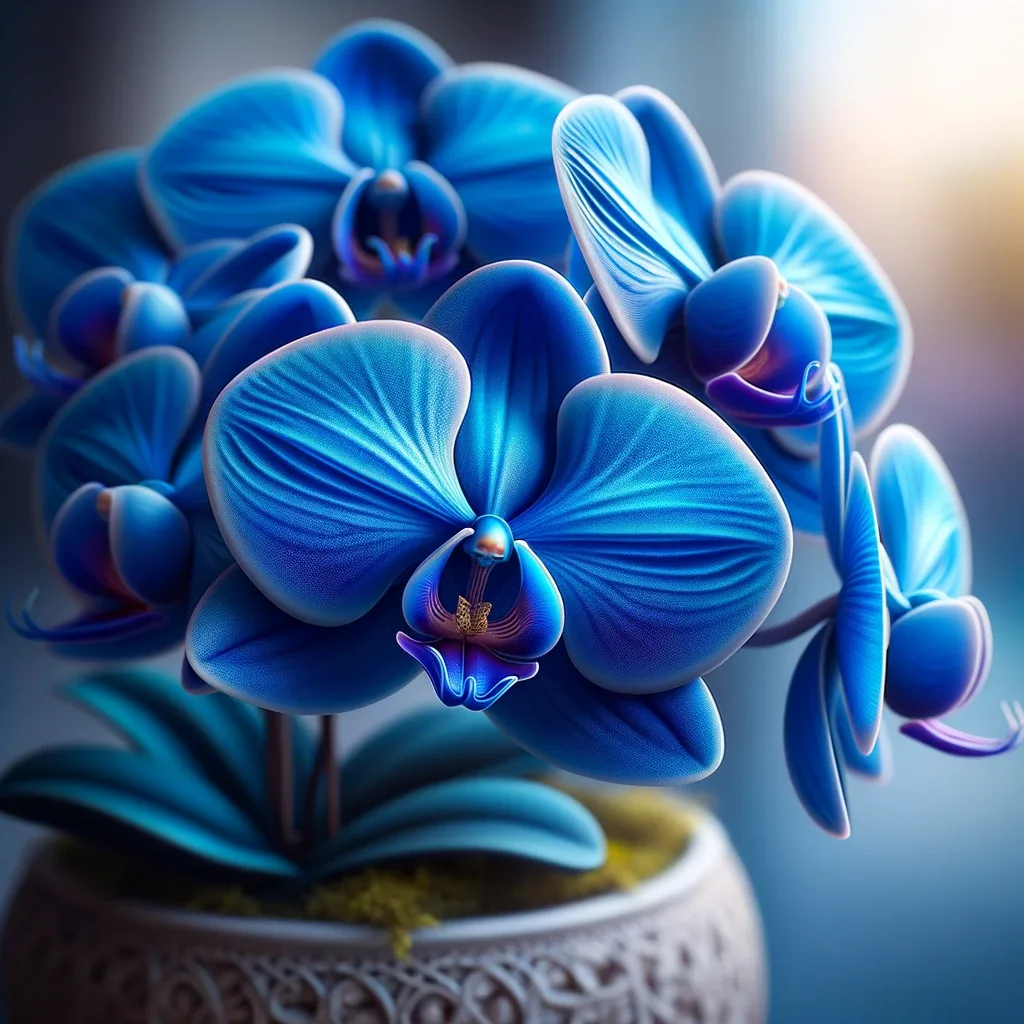
Why it’s a great houseplant: The Blue Mystique Phalaenopsis, commonly known as the Blue Orchid, features stunning electric blue orchid blooms, making it a unique and captivating indoor plant. Its vibrant color adds a touch of elegance and sophistication to your indoor garden.
Care Tips:
- Light: Place in bright, indirect light to encourage blooming.
- Water: Water sparingly, allowing the potting medium to dry slightly between waterings.
- Temperature: Maintain a consistent, moderate temperature for optimal orchid health.
25. Blue Lace Flower (Trachymene coerulea)
Why it’s a great houseplant: Blue Lace Flower is a charming annual with delicate, sky-blue flowers that provide a splash of color to indoor gardens. It’s known for its airy, lacy appearance and is perfect for adding a touch of cottage garden charm to your home decor.
Care Tips:
- Light: Place in bright, indirect light or partial sun.
- Water: Keep the soil consistently moist but not waterlogged.
- Deadheading: Remove spent flowers to encourage continuous blooming.
24. Blue Star Fern (Phlebodium Aureum)
Why it’s a great houseplant: The Blue Star Fern is known for its attractive, silvery-blue foliage that adds a touch of elegance and serenity to indoor spaces. It’s a low-maintenance fern that thrives in lower light conditions, making it an ideal choice for homes with limited natural light.
Care Tips:
- Light: Place in low to medium indirect light. Avoid direct sunlight.
- Water: Keep the soil consistently moist but not soggy. Water when the top inch of the soil feels dry.
- Humidity: Maintain moderate to high humidity, which is typical for ferns. Regular misting or the use of a humidity tray can help.
23. Blue Sage (Salvia Azurea):
Why it’s a great houseplant: Blue Sage is a charming indoor plant known for its beautiful blue flowers. It not only adds color but also attracts pollinators, making it a lively and visually appealing addition to your indoor garden.
Care Tips:
- Light: Provide bright, indirect light or partial sun exposure.
- Water: Keep the soil consistently moist but not waterlogged.
- Humidity: Maintain moderate indoor humidity levels.
22. Blue Fernleaf (Selaginella Uncinata):
Why it’s a great houseplant: Blue Fernleaf is a unique and visually striking indoor plant with silvery-blue, feathery foliage. It brings an intriguing texture and color to your indoor garden and thrives in low-light conditions.
Care Tips:
- Light: Thrives in low to medium indirect light or even low-light conditions.
- Water: Keep the soil consistently moist, but do not overwater.
- Humidity: Prefers higher humidity levels; misting or using a humidity tray can be beneficial.
21. Blue Bunny Ear Cactus (Opuntia Microdasys)
Why it’s a great houseplant: Blue Bunny Ear Cactus features distinctive flattened pads with a blue-green tint and tiny spines. It’s a visually appealing and low-maintenance succulent that adds a touch of the Southwest to your indoor garden.
Care Tips:
- Light: Place in bright, indirect light or partial sun.
- Water: Water sparingly, allowing the soil to dry out between waterings.
- Humidity: It thrives in low humidity and can adapt to drier indoor conditions.
20. Blue Kalanchoe (Kalanchoe Thyrsiflora)
Why it’s a great houseplant: Blue Kalanchoe, also known as “Paddle Plant,” has striking blue-gray, paddle-shaped leaves. It’s a visually appealing and low-maintenance vining plant that adds a touch of charm to any indoor space.
Care Tips:
- Light: Place in bright, indirect light.
- Water: Allow the soil to dry slightly between waterings, and be cautious not to overwater.
- Humidity: Maintain moderate humidity levels for optimal growth.
19. Blue Butterfly Bush (Buddleja Davidii)
Why it’s a great houseplant: Blue Butterfly Bush is an attractive indoor plant known for its fragrant blue-purple flowers that attract butterflies and other pollinators. It adds a delightful and aromatic touch to your indoor garden.
Care Tips:
- Light: Place in bright, indirect light or partial sun exposure.
- Water: Keep the soil consistently moist but not waterlogged, allowing the top inch of soil to dry between waterings.
- Humidity: Maintain moderate indoor humidity levels.
18. Blue Waxbill (Uraeginthus Angolensis)
Why it’s a great houseplant: Blue Waxbill is a small and brightly colored finch known for its striking blue and orange plumage. While not a traditional houseplant, it can be kept in a spacious indoor aviary or large enclosure, adding vibrant avian beauty to your living space.
Care Tips:
- Habitat: Provide a spacious aviary with room to fly.
- Diet: Offer a varied diet of seeds, fresh fruits, and vegetables.
- Social Interaction: Blue Waxbills are social birds and thrive with companionship.
17. Blue Columnea (Columnea spp.)
Why it’s a great houseplant: Blue Columnea is a charming indoor plant known for its unique blue, tubular flowers and trailing growth habit. It adds a touch of vibrancy and elegance to your indoor garden, making it an eye-catching addition.
Care Tips:
- Light: Provide bright, indirect light to dappled sunlight.
- Water: Keep the soil consistently moist but not waterlogged, allowing the top inch of soil to dry between waterings.
- Humidity: Maintain moderate indoor humidity levels, and mist the plant as needed to boost humidity.
16. Blue Starburst Bromeliad (Neoregalia Spectabilis)
Why it’s a great houseplant: Blue Starburst Bromeliad is a captivating bromeliad species known for its blue-green rosette and vibrant central bloom. It’s an excellent choice for adding a tropical touch to your indoor space and purifying the air.
Care Tips:
- Light: Place in bright, indirect light to maintain its vibrant colors.
- Water: Keep the central cup filled with water, and mist the plant regularly.
- Temperature: Maintain a warm, humid environment for optimal growth.
15. Blue Euphorbia (Euphorbia Lactea ‘Blue’)
Why it’s a great houseplant: Blue Euphorbia is a striking succulent with a unique bluish hue and intriguing branching patterns. It’s drought-tolerant and requires minimal maintenance, making it an ideal choice for busy indoor gardeners.
Care Tips:
- Light: Provide bright, indirect light or filtered sunlight.
- Water: Water sparingly, allowing the soil to dry completely between waterings.
- Soil: Use a well-draining cactus or succulent potting mix.
14. Blue Passionflower (Passiflora Caerulea)
Why it’s a great houseplant: Blue Passionflower is a climbing vine known for its intricate blue and white flowers, which are not only visually stunning but also attract pollinators like butterflies and bees. It adds a touch of exotic beauty to indoor spaces.
Care Tips:
- Light: Provide bright, indirect light or filtered sunlight.
- Water: Keep the soil consistently moist but not waterlogged.
- Support: Offer a trellis or support structure for the vine to climb.
13. Blue Plumbago (Plumbago Auriculata)
Why it’s a great houseplant: Blue Plumbago is an evergreen shrub with clusters of sky-blue flowers and lush green foliage. It’s a delightful addition to indoor gardens, known for its extended blooming period and versatility as both a potted plant and hanging basket specimen.
Care Tips:
- Light: Place in bright, indirect light or partial sun.
- Water: Keep the soil evenly moist during the growing season.
- Pruning: Trim to maintain its shape and encourage more blooms.
12. Blue Lavender (Lavandula spp.)
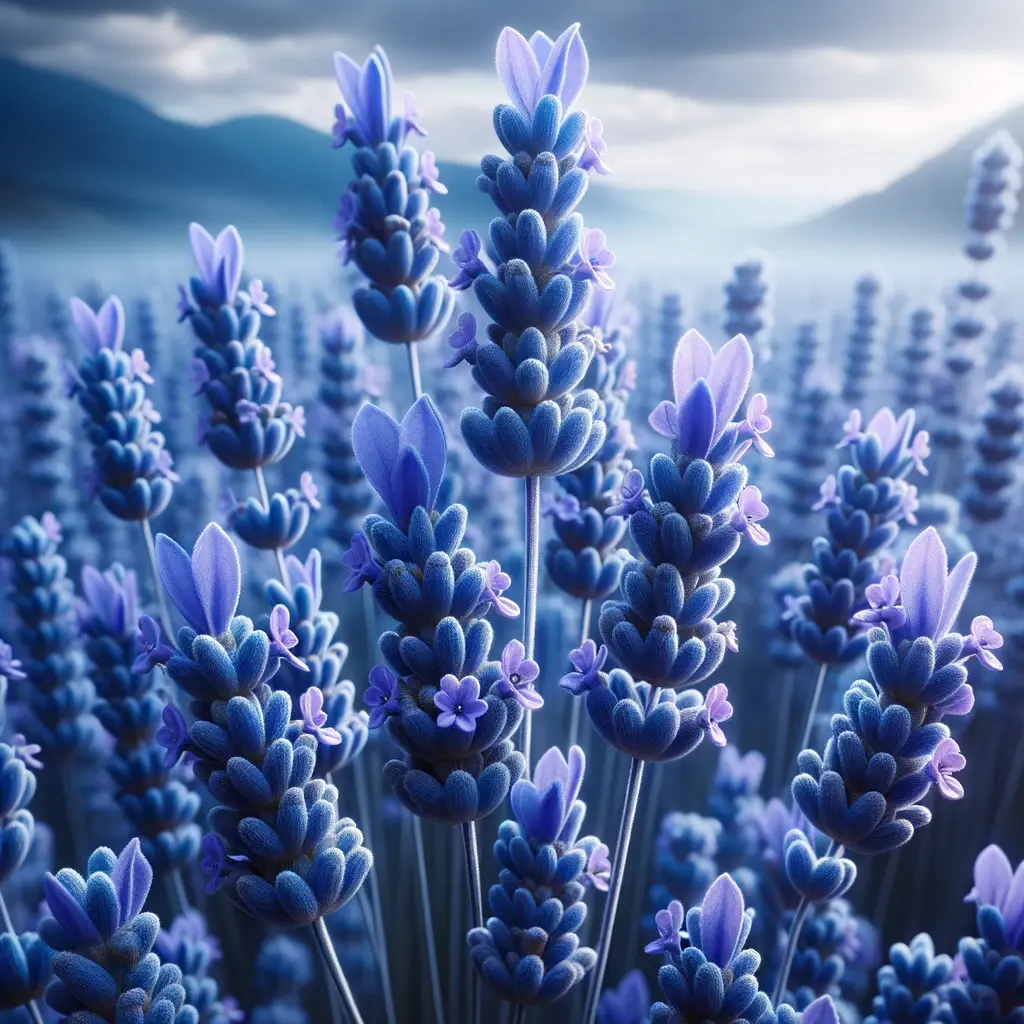
Why it’s a great houseplant: Lavender is well-known for its aromatic blue-gray foliage and soothing fragrance. It’s a fantastic houseplant that not only adds a touch of relaxation to your indoor space but can also be used for culinary and aromatic purposes.
Care Tips:
- Light: Provide bright, direct sunlight for at least 6-8 hours a day.
- Water: Allow the soil to dry out between waterings, and avoid overwatering.
- Pruning: Regularly trim to maintain its shape and encourage bushier growth.
11. Blue Star Creeper (Isotoma Fluviatilis)
Why it’s a great houseplant: Blue Star Creeper is a charming indoor plant known for its tiny, star-shaped blue flowers and creeping, ground-covering growth habit. It adds a delicate and enchanting element to your indoor garden, making it a unique and eye-catching addition.
Care Tips:
- Light: Provide bright, indirect light or partial shade.
- Water: Keep the soil consistently moist but not waterlogged, allowing the top inch of soil to dry between waterings.
- Humidity: Maintain moderate indoor humidity levels.
10. Blue Leadwort (Ceratostigma Plumbaginoides)
Why it’s a great houseplant: Blue Leadwort is a versatile and low-growing indoor plant known for its vivid blue flowers and attractive, bronze-colored foliage. It adds a burst of color and unique texture to your indoor garden and can be grown in containers or as ground cover.
Care Tips:
- Light: Provide bright, indirect light or partial sun exposure.
- Water: Keep the soil consistently moist, allowing it to dry slightly between waterings.
- Humidity: Blue Leadwort is adaptable to typical indoor humidity levels.
9. Blue Sky Vine (Thunbergia grandiflora)
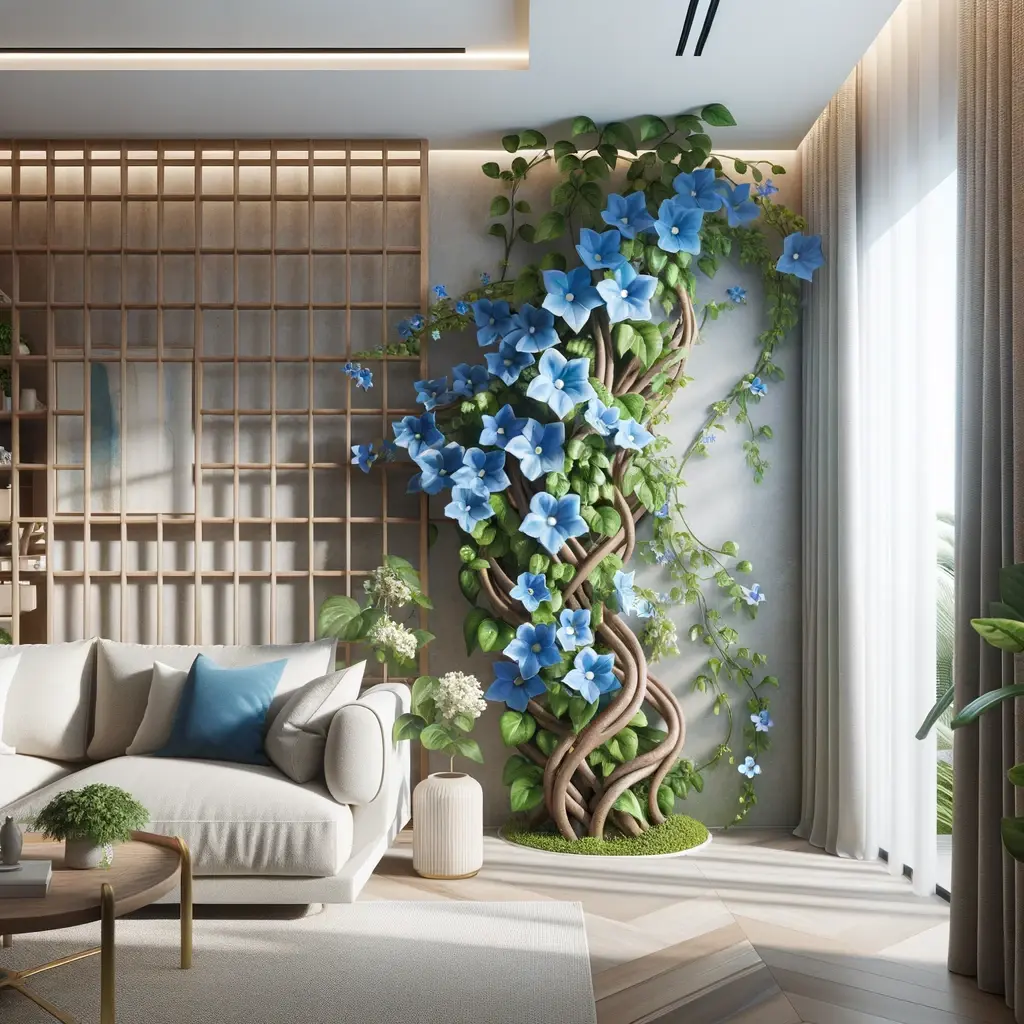
Why it’s a great houseplant: Blue Sky Vine is a climbing vine with vibrant, sky-blue, trumpet-shaped flowers. It’s an excellent choice for creating a vertical garden indoors and adding a splash of color to your living space.
Care Tips:
- Light: Provide bright, indirect light or filtered sunlight.
- Water: Keep the soil consistently moist during the growing season.
- Support: Offer a trellis or support structure for the vine to climb.
8. Blue Globe Thistle (Echinops ritro)
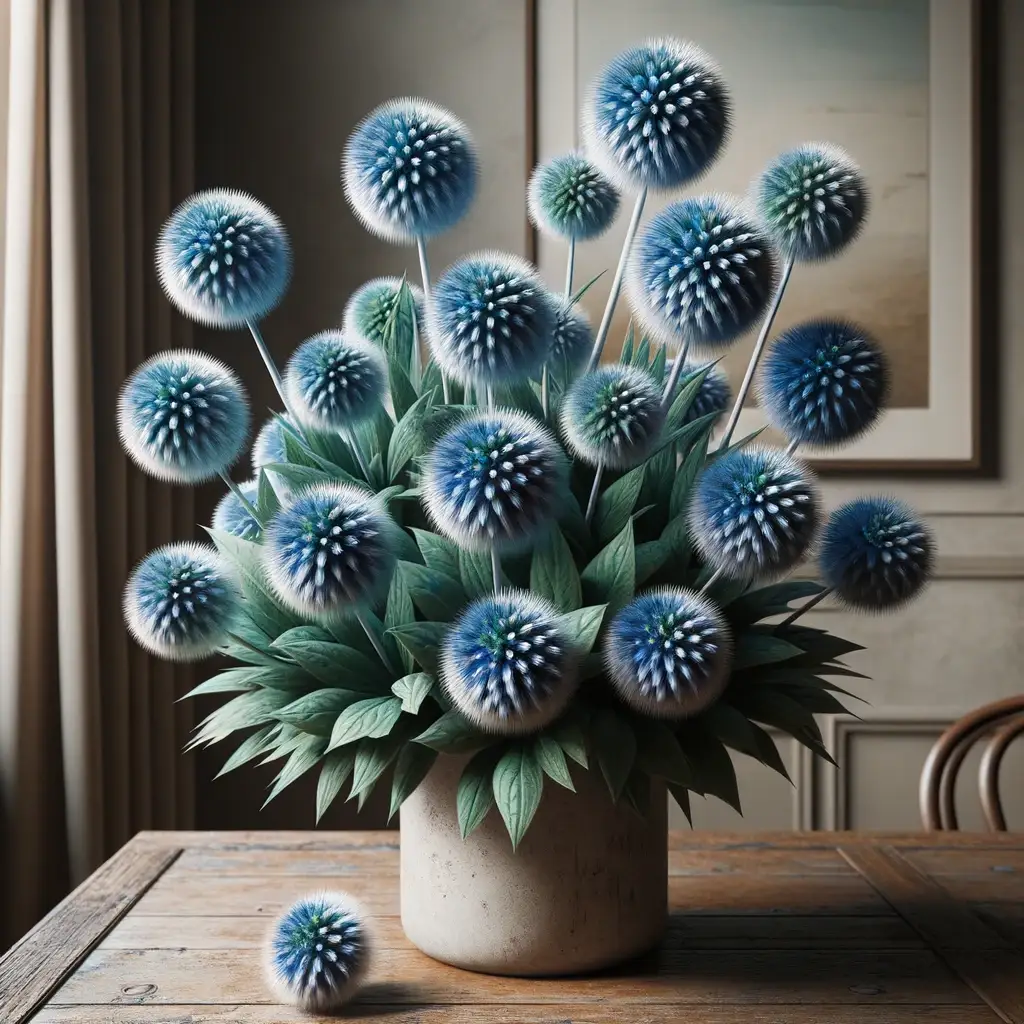
Why it’s a great houseplant: Blue Globe Thistle is a perennial with spherical blue flower heads that attract pollinators like bees and butterflies. It’s a visually striking and unique addition to indoor gardens, adding a touch of wild beauty to your space.
Care Tips:
- Light: Place in bright, indirect light or partial sun.
- Water: Keep the soil evenly moist during the growing season.
- Deadheading: Remove spent blooms to encourage more flowering.
7. Blue Daisy (Felicia amelloides)
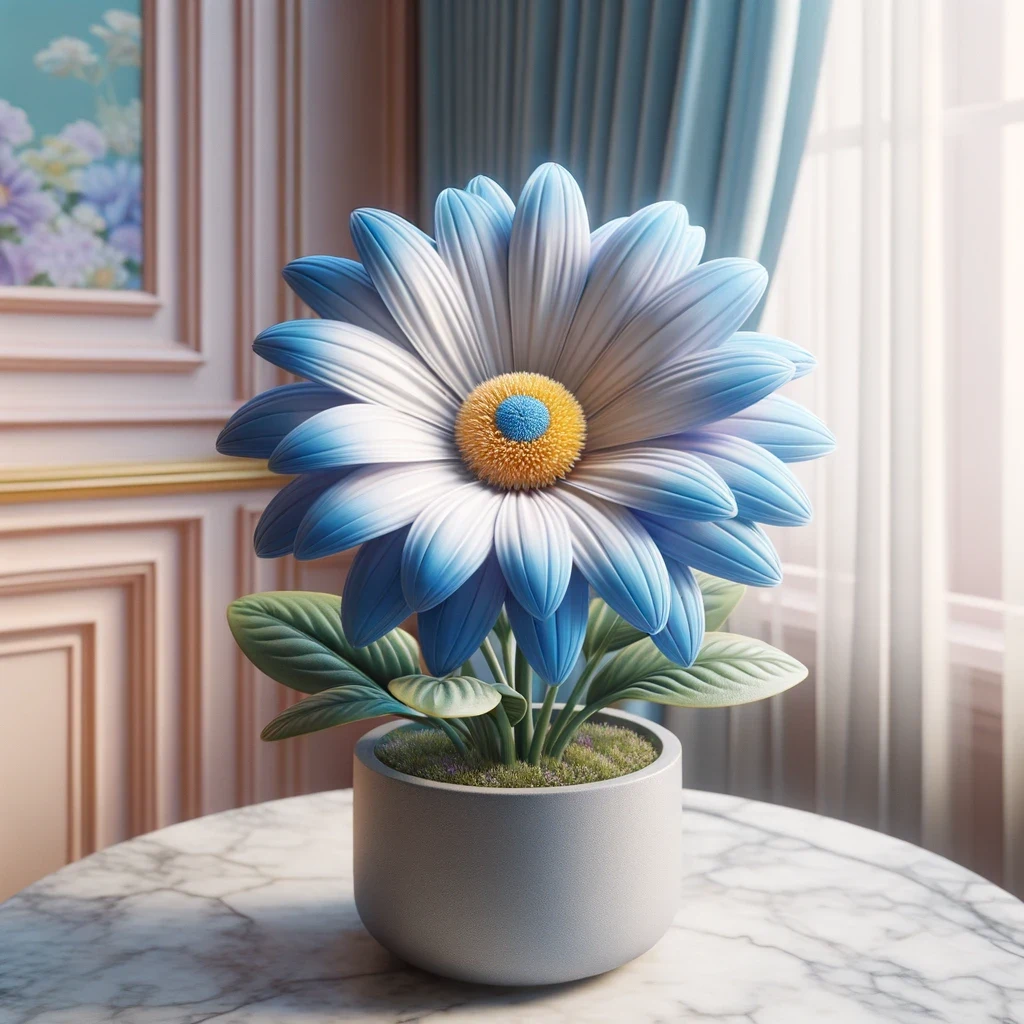
Why it’s a great houseplant: Blue Daisy, also known as “Blue Marguerite,” boasts cheerful blue flowers with bright yellow centers. It’s a charming and low-maintenance plant that adds a touch of color and charm to indoor arrangements.
Care Tips:
- Light: Provide bright, indirect light or partial sun.
- Water: Keep the soil consistently moist but not waterlogged.
- Pruning: Trim to maintain its shape and encourage more blooms.
6. Blue Anemone (Anemone blanda)

Why it’s a great houseplant: Blue Anemone is a bulbous plant with dainty, blue-violet flowers that create a carpet of color. It’s perfect for indoor containers and adds a delightful burst of early spring color to your indoor garden.
Care Tips:
- Light: Place in bright, indirect light or partial sun.
- Water: Keep the soil consistently moist during the growing season.
- Bulb Care: Allow the bulbs to rest after flowering and then store them in a cool, dry place.
5. Blue Hibiscus (Alyogyne huegelii)

Why it’s a great houseplant: Blue Hibiscus, with its large, vibrant blue or purple flowers, adds a tropical flair to indoor gardens. It’s a captivating and eye-catching choice that thrives when provided with the right care.
Care Tips:
- Light: Place in bright, indirect light or partial sun.
- Water: Keep the soil consistently moist but not waterlogged.
- Pruning: Trim to maintain its shape and encourage more blooms.
4. Blue Myrtle (Myrtus communis ‘Blue Carpet’)
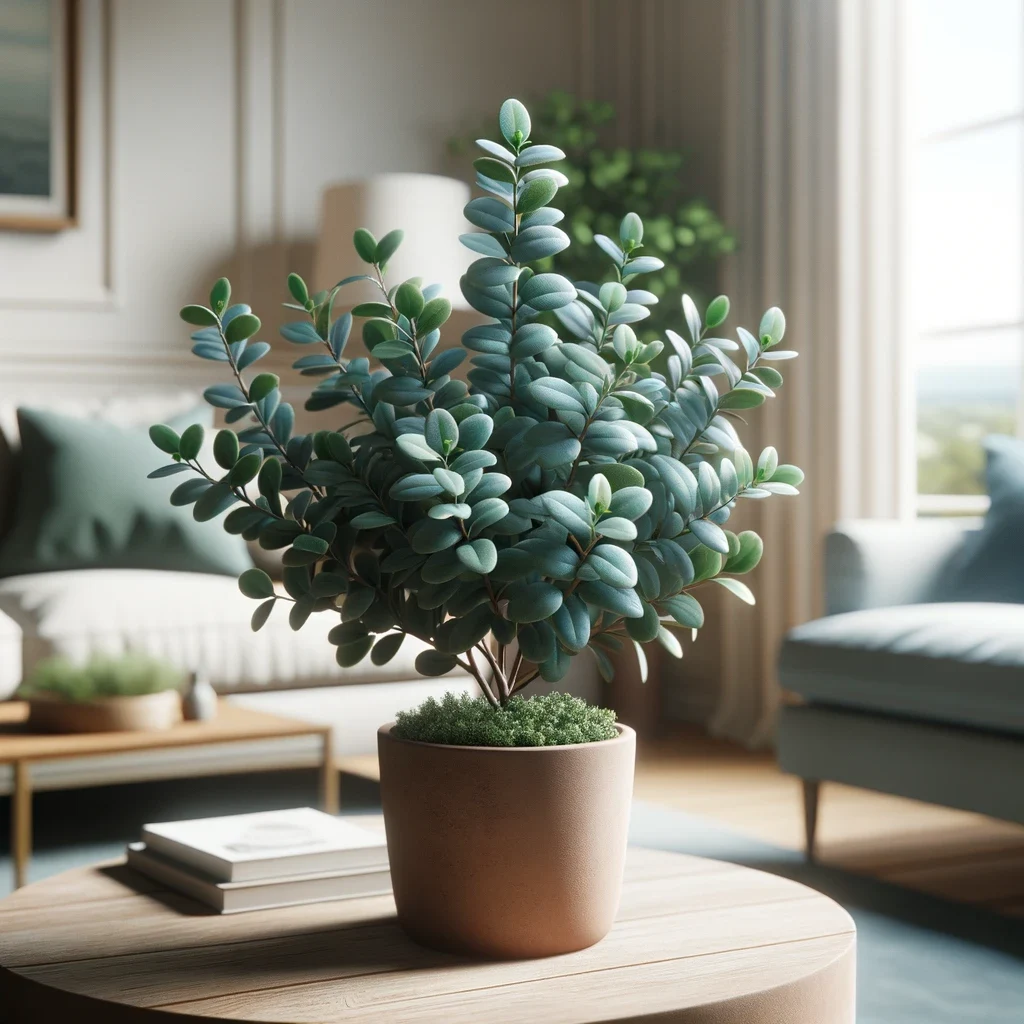
Why it’s a great houseplant: Blue Myrtle, or “Blue Carpet,” features aromatic blue-gray foliage and small white flowers. It’s a fragrant and visually appealing plant, perfect for adding a Mediterranean touch to your indoor space.
Care Tips:
- Light: Provide bright, indirect light or partial sun.
- Water: Keep the soil evenly moist during the growing season.
- Pruning: Trim to shape and promote bushy growth.
3. Blue Plumbago (Plumbago auriculata)

Why it’s a great houseplant: Blue Plumbago is an evergreen shrub with clusters of sky-blue flowers and lush green foliage. It’s a delightful addition to indoor gardens, known for its extended blooming period and versatility as both a potted plant and hanging basket specimen.
Care Tips:
- Light: Place in bright, indirect light or partial sun.
- Water: Keep the soil evenly moist during the growing season.
- Pruning: Trim to maintain its shape and encourage more blooms.
2. Blue Jacaranda (Jacaranda mimosifolia)

Why it’s a great houseplant: Blue Jacaranda, with its stunning blue-purple blossoms, adds a touch of exotic beauty to indoor spaces. It’s a deciduous tree that can be grown in a large pot, making it an impressive and visually appealing choice.
Care Tips:
- Light: Place in bright, indirect light or partial sun.
- Water: Keep the soil consistently moist during the growing season, and reduce watering in the dormant period.
- Pruning: Prune to shape and manage its size.
1. Blue Rose (Rosa spp.)
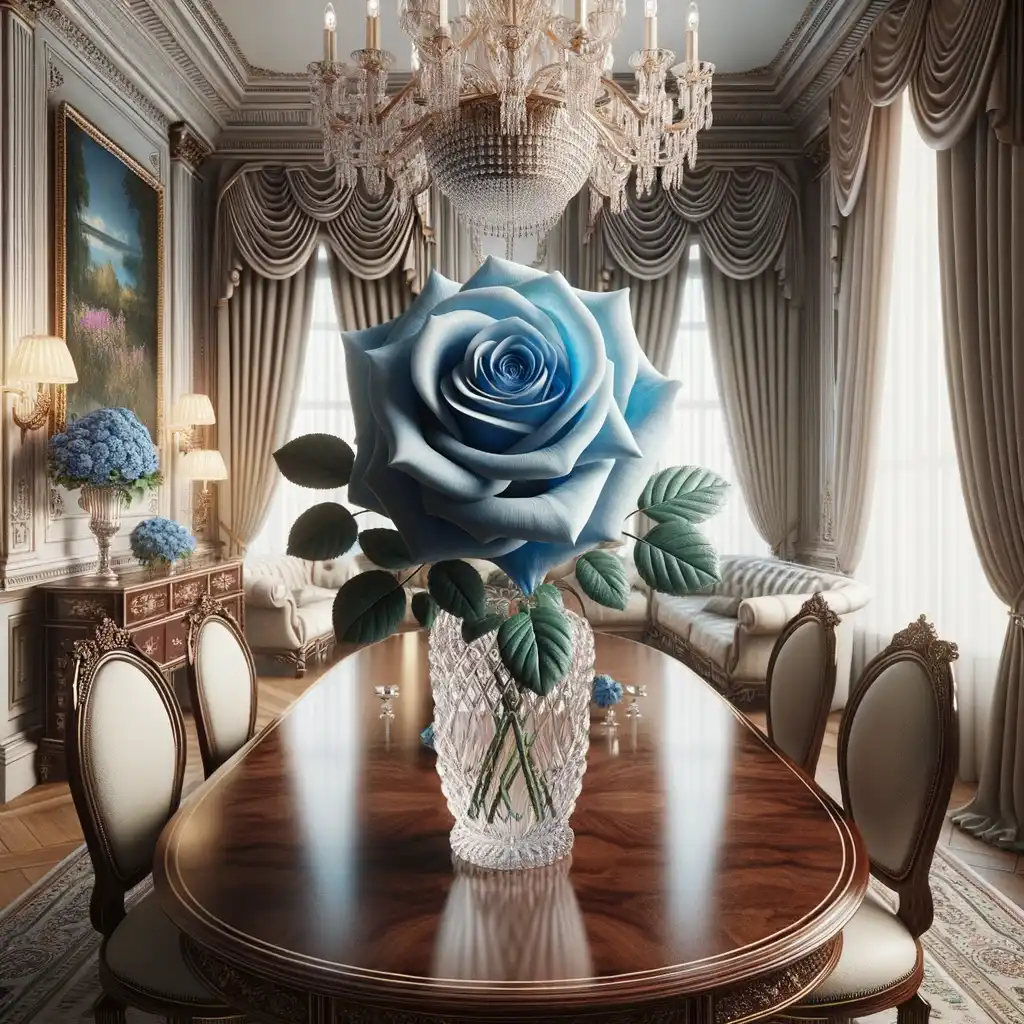
Why it’s a great houseplant: Blue Roses, while not naturally occurring, are created through selective breeding and dyeing techniques. They offer a symbol of mystery and enchantment and make for a striking and unique addition to your indoor garden.
Care Tips:
- Light: Provide bright, indirect light or partial sun.
- Water: Keep the soil evenly moist, but avoid waterlogging.
- Fertilization: Feed with a balanced liquid fertilizer during the growing season.





